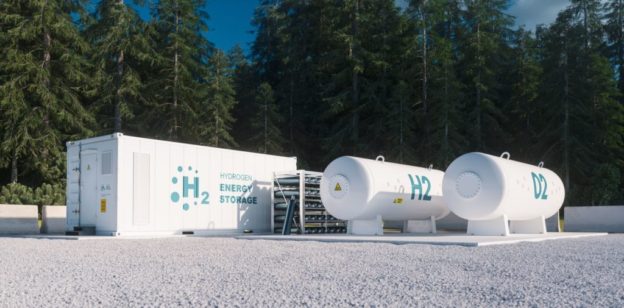The Indian government approved the National Green Hydrogen Mission in January to achieve a green hydrogen production capacity of at least 5 million metric tons (mmt) and an additional 125 GW of renewable energy capacity by 2030.
The Mission intends to significantly reduce carbon dioxide (CO2) emissions by 2030 by promoting the demand for, production of and use of green hydrogen in diverse industries. This will help to achieve its goal of reducing annual greenhouse gas emissions by approximately 50 mmt. The Mission also intends to establish a coordinated program for skill development, which will result in numerous job possibilities.
Most importantly, the Mission wants to boost green hydrogen exports while lowering fossil-fuel imports. The program’s motivation is to focus on domestic electrolyzer manufacture and green hydrogen production. Green hydrogen is created through electrolysis using renewable electricity.
Given that India’s internal power-consumption needs are anticipated to increase significantly over the next 20 years, the country’s dependence on fossil fuels has been a source of concern. Green hydrogen, solar and wind energy could be the future solution for India, which now imports more than 80% of its oil needs. In a way, this benefits the renewable-energy industry because solar-generated electricity can power the manufacture of green hydrogen.
According to experts, the National Green Hydrogen Mission’s lofty objectives are essential for projecting India as an export hub for green hydrogen to the Middle East, Southeast Asia and Africa and luring foreign investors. They will also help decarbonize industries like oil refineries, iron, steel and cement while producing ammonia and methanol.
Applications of green hydrogen
Hydrogen is the only element on Earth with a proton and an electron. The ability to store and distribute useable energy makes hydrogen an energy carrier rather than an energy source.
Due to its high volatility, hydrogen must interact with other elements to become stable. It produces water when combined with oxygen. Hydrogen and oxygen are separated from water using electrolysis equipment that runs on renewable electricity. This makes it perfect for use in fuel cells and other types of energy-storage systems. A fuel cell is a device that turns the electrochemical reaction of hydrogen and oxygen into water into electricity. Aside from energy, the only byproducts of hydrogen fuel-cell reactions are water and heat, with no CO2 emissions.
Hydrogen fuel cells are being offered to replace rechargeable lithium-ion batteries in carbon-free mobility platforms like electric vehicles (see figure).
Producing green hydrogen
Today, only a small portion of the hydrogen consumed annually worldwide is created using green energy; the great majority is still produced using electricity derived from fossil fuels. The cost of producing green hydrogen is one of the difficulties. It must be more affordable than energy sources like fossil fuels and power stored in lithium-ion batteries if it is to be widely utilized.
In electrolyzers, which are machines that use electrical energy to break water molecules into hydrogen and oxygen gas through a process known as electrolysis, hydrogen plays a critical role. A container termed an electrolysis cell, which has two electrodes—a positively charged anode and a negatively charged cathode—that are separated by an electrolyte solution, is used to electrolyze water in an electrolyzer. Water molecules split into components when an electric current is applied to them. Hydrogen ions (H+) are drawn to the negatively charged cathode, while oxygen ions (O2–) are drawn to the positively charged anode.
Hydrogen gas (H2) is created at the cathode when the hydrogen ions take up electrons from the electric current. This gas is collected and used as fuel. Meanwhile, the oxygen ions at the anode give off electrons and combine to generate oxygen gas (O2), which is usually discharged into the atmosphere. In electrolyzers, hydrogen serves as one of the byproducts of the electrolysis process, which can subsequently be collected and used as a clean, sustainable energy source.
Alkaline and polymer electrolyte membrane (PEM) electrolyzers are two types of electrolysis technologies used for producing hydrogen gas from water through electrolysis.
Alkaline electrolysis is one of the oldest and most well-established electrolysis technologies. An aqueous solution of potassium hydroxide (KOH) or sodium hydroxide (NaOH) serves as the electrolyte, and nickel or stainless-steel electrodes are used in alkaline electrolyzers. When an electric current is passed through the electrolyte, the water is split into hydrogen and oxygen gas at the cathode and anode, respectively. Alkaline electrolyzers are known for their efficiency, durability and ability to handle large-scale hydrogen production.
On the other hand, PEM electrolysis is a newer technology that has gained popularity in recent years. A solid polymer membrane conducting protons (H+) is the electrolyte in PEM electrolyzers. When an electric current is passed through the membrane, water is split into hydrogen and oxygen gas at the anode and cathode, respectively. PEM electrolyzers have several advantages over alkaline electrolyzers, including higher efficiency, faster response time and greater flexibility in operation and maintenance.
Both alkaline and PEM electrolyzers are essential technologies for producing hydrogen gas through electrolysis. Each has unique advantages and limitations depending on the specific application and scale of hydrogen production required.
In terms of calorific value, hydrogen has almost more than 2.5× the energy per ton compared with natural gas, which means 5 million tons of H2 can replace almost 18 billion cubic meters of natural gas.
https://www.powerelectronicsnews.com/india-develops-strategy-for-producing-green-hydrogen/






